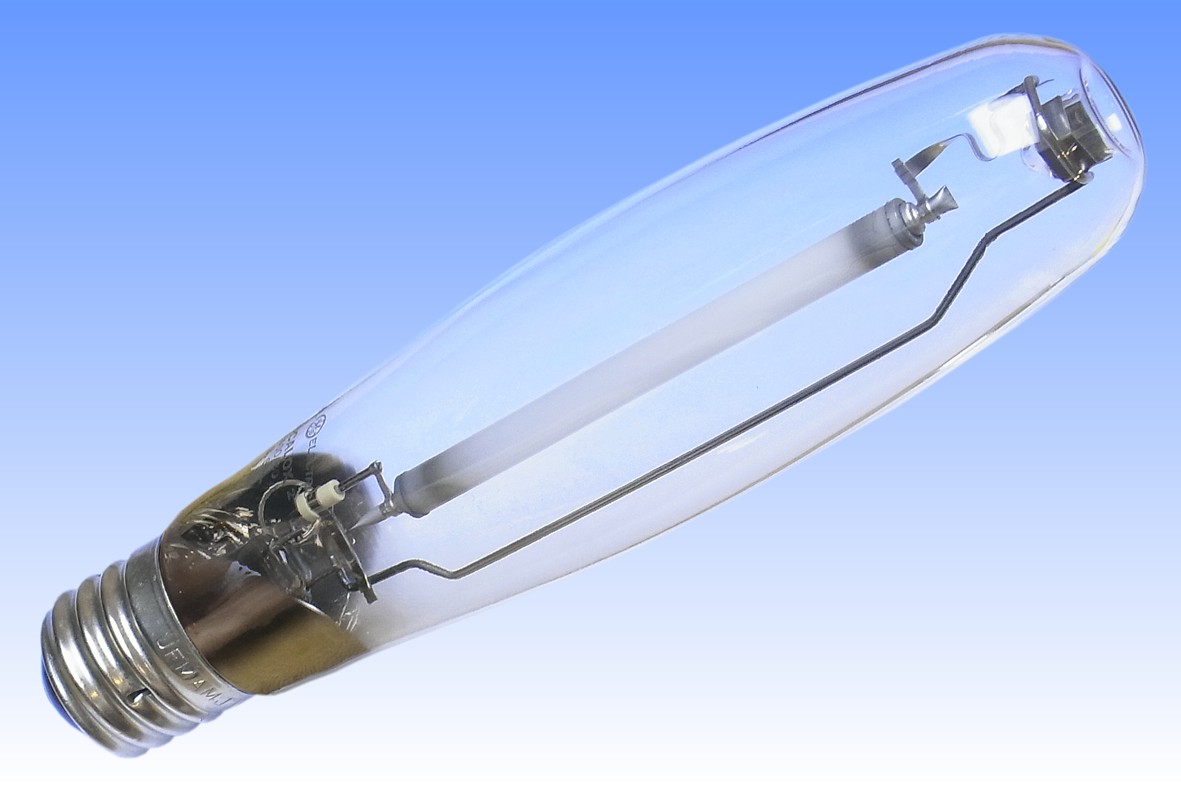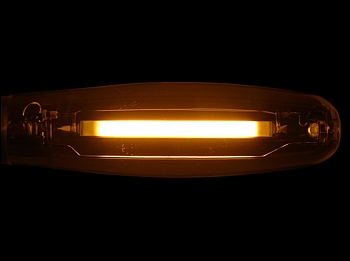
|
GE Lucalox LU400/BD with External Amalgam Reservoir |

The design was improved in 1967 by this lamp, featuring an external amalgam reservoir. The niobium caps are shallower and one of them is pierced by a long niobium tube, which represents a well-controlled cold spot and excess amalgam condenses here. The outer end is pinched closed by cold welding to seal the arc tube. It also extends into the arc tube and is TIG-welded to the electrode shank. At the other end a shorter niobium tube is welded to the cup but does not penetrate inside. It contains an yttrium pellet which acts as a getter for hydrogen diffusing through the niobium cup. Note also the anti back-arcing shields behdind the electrodes to prevent puncture of the niobium cups during starting.
The external reservoir was a success in slowing voltage rise and extending life. It also allowed fine-tuning of voltage, by sandblasting part of its surface to radiate more heat, or applying a niobium band around the arc tube to reduce heat loss. But a drawback was the asymmetric design. The amalgam must always be at the lower end, otherwise it may drip into the arc tube and extinguish the discharge due to a sudden rise in voltage - or crack the ceramic by thermal shock. Separate lamps had to be made for Base Up and Base Down use. It was not until 1977 that GE developed the so-called Butterfly Crimp to keep the amalgam inside the reservoir, that universal lamps became feasible again.




| Manufacturer: | General Electric Company U.S.A. | |
| Lamp Power: | 400 Watts | |
| Lamp Current: | 4.7 Amps | 7A during starting |
| Lamp Voltage: | 100 Volts | 2500-4000V ignition |
| Cap Type: | E39s/41 | Ni plated brass + vitrite |
| Bulb Type: | ED-57 | ED-18 in eighths/inch |
| Bulb Finish: | Clear | Lead borosilicate glass |
| Electrodes: | Double tungsten coils | Ba2CaWO6 Emitter |
| Arc Length: | 86.9 mm | 3.42 inches |
| Atmosphere: | Inner: Na,Hg | Xe | Outer: Hard Vacuum |
| Luminous Flux: | 47,000 lm (@ 100 hrs) | 42,300 lm (@ 7,500hrs) |
| Luminous Efficacy: | 117.5 lm/W (@ 100 hrs) | 105.8 lm/W (@ 7,500hrs) |
| Colour Temperature & CRI: | CCT: 2100K | CRI: Ra 25 |
| Chromaticity Co-ordinates: | CCx: 0.512 | CCy: 0.420 |
| Rated Lifetime: | 15,000 hours | to 50% survival |
| Warm-up & Re-strike Time: | 3-4 minutes | 1 minute |
| Burning Position: | Vertical Base Down ± 95° | |
| Overall Length: | 248 mm | 93/4 inches |
| Light Centre Length: | 146 mm | 53/4 inches |
| Factory: | Cuyahoga, NELA Park | Cleveland OH, U.S.A. |
| Date of Manufacture: | August 1971 | Date Code: 92 - |
| Original Value: | US $55.00 (1972) | |

